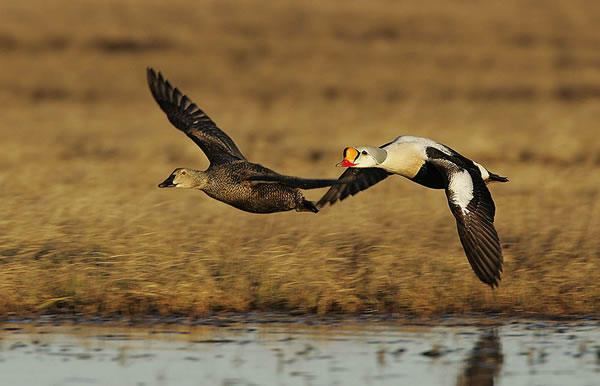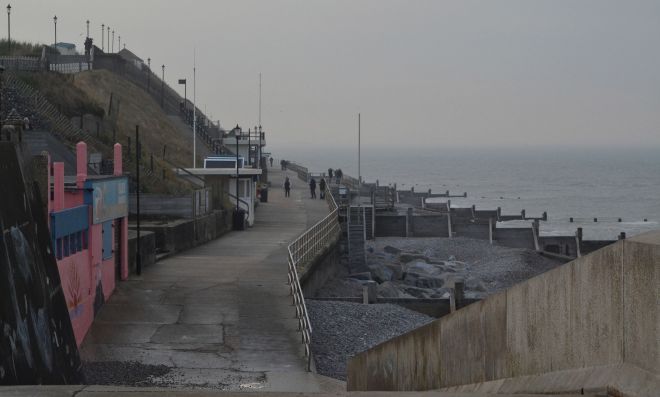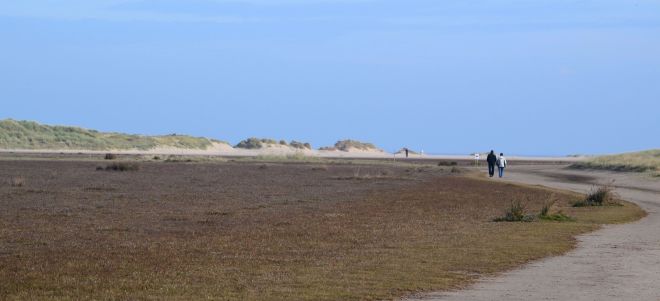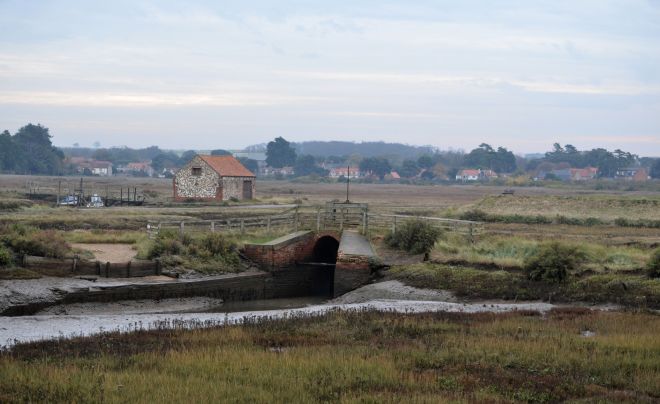This was an opportunity I thought over for a while but that ultimately needed to be taken. Not too many King Eider stray far south of Aberdeenshire where several, mostly drakes regularly winter, but for the previous seven days an immature male had settled offshore from the Norfolk seaside town of Sheringham. Twice in the last two years I had travelled to the Dyfi estuary in west Wales to try for a female that is reported there sporadically, without success.
Both places are a little beyond my usual range, but King Eider is a difficult bird to catch up with other than in Aberdeenshire; hence my willingness to push out the boundaries. Northern Norway, where it is possible to hire a floating hide expensively to get out amongst them, is of course even further. The Norfolk bird, that is described as a second winter drake, would not be as good as seeing the rather magnificent adults further afield, but also more distinctive than the drab Ceredigeon duck.

King Eider (male and female) © rights of owner reserved
King Eider (pictured above) is a common breeder in Arctic regions of Europe, north America and Asia, and mostly remains at high latitudes throughout the year. Adult males are as unmistakable as they are handsome, though females are not too dissimilar to the slightly larger Common Eider. This species is very rare in England, but I understand they are prone to over-wintering where they do occur south of the Arctic, so maybe this one might mature on-site.
Upon rising on Monday morning (5th) I decided to put things to the B&B test. If I could find reasonably priced overnight accommodation I would go to Sheringham. So when a last minute single room for £38 in nearby Cromer beckoned my mind was made up. The travelling distance was not actually as far as anticipated and I arrived on Sheringham’s seafront at 1:30pm.

Sheringham’s western promenade from where the King Eider was being viewed
Most sightings on RBA had been from the lifeboat station that I now ascertained was at the far end of the rather nondescript promenade (pictured above) just to the west of the town. When I got there several other birders were already watching the King Eider out on the sea, and once I too located this much sought lifer things were as easy as that. There would now be a certain amount of time to fill so I stayed and watched my quest for some time.
In around 90 minutes on-site the KE didn’t come closer inshore, remaining at roughly the same distance bobbing in and out of view on the waves and diving in overcast light. There were hence the proverbial two chances of getting a picture, slim and none. These images (below) rather push “showing how the bird was seen” out to the limit, but were all I was likely to get. For the RBA gallery of this bird see here but this (here) on Bird Guides is better.
At just after 3pm I decided to explore the locality, and allowing for the season found “Norfolk’s premier seaside town” as Sheringham proclaims itself to be a dullish and faded sort of place from a former age, with an overall impression of rather too much ugly, weather-stained concrete. Necessary as those sea defences are, the place was hardly picturesque. Then, my parking time having run out, I moved on the few miles to Cromer and my B&B.
With this experience, I have now observed all three of Europe’s regularly occurring Eiders, the others being Steller’s Eider in Estonia (April 2017) and Common Eider a number of times in England. It would perhaps have seemed churlish to head straight home on Tuesday (6th) with the north Norfolk coast at my disposal, and so overnight I checked out what else was about. Amongst the various records on RBA, several Shorelark at Holkham Gap and Twite at Thornham Harbour stood out. And since these are both prime birding locations I reasoned those classic Norfolk wintering species might not be too difficult to find.
Hence, having raided a petrol station store of its end of day mark downs, I forewent a full English breakfast and set off fairly early west along the A149 coastal road. Arriving at 8:30am in the Holkham NNR car park at the end of Lady Anne’s Drive I fed the rapacious pay and display machine then walked east into the coastal habitat between Wells Wood and the sea. Here (TF895455) there is what is described as a regular wintering site for Shorelark and Snow Bunting.

Coastal Shorelark habitat at Holkham NNR
The previous day this had been cordoned off to discourage photographers and other people with cameras, presumably from chasing the birds around. The area in question is now an enclosure complete with notices appealing to visitors to give the birds space and keep a respectful distance. Everywhere now in birding there is that field underclass of people with little actual knowledge of wildlife, and far more technology than field craft, though all encouraged by conservation charities in their insatiable desire for new members. I say that because seasoned wildlife enthusiasts, whom the same organisations now prefer to disregard, do not generally do what was being described in the notices.
Unfortunately the disturbance created by the measures taken for these birds protection appeared to have caused them to relocate, at least temporarily and of either Shorelark or Snow Bunting there was no sign. As at Sheringham I felt constrained here by the amount of parking time I had purchased and so stayed for around 90 minutes again. I would have preferred the option to obtain a day permit, since I was after all visiting a national nature reserve. Back at the car park the seasonal Geese (pictured below) in the fields alongside made this visit worthwhile, especially the Pink-footed Geese that I always enjoy experiencing on any winter visit to north Norfolk.
Then, filing the place with the enclosure away in my mind for future reference, I moved on to Thornham and another NNR, Holme Dunes (pictured below). There I came across a large flock of Twite feeding on the salt marsh at what is also a regular site for that winter Finch. Having filled the morning in this way I now felt better value for making the overnight stay.

Part of Holme Dunes NNR looking towards Thornham
As weather conditions became more threatening I headed for home early to avoid rush hour traffic around Peterborough and Northampton. I left feeling it’s a pity Norfolk is up to four hours from home, since it always looks like there is lots to do there but on day visits such as this one I somehow never get enough time to do things justice.







